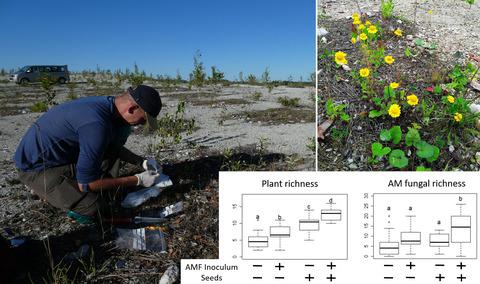当前位置:
X-MOL 学术
›
J. Appl. Ecol.
›
论文详情
Our official English website, www.x-mol.net, welcomes your
feedback! (Note: you will need to create a separate account there.)
Co‐introduction of native mycorrhizal fungi and plant seeds accelerates restoration of post‐mining landscapes
Journal of Applied Ecology ( IF 5.0 ) Pub Date : 2020-06-22 , DOI: 10.1111/1365-2664.13663 Tanel Vahter 1 , Carlos Guillermo Bueno 1 , John Davison 1 , Koit Herodes 2 , Inga Hiiesalu 1 , Liis Kasari‐Toussaint 1 , Jane Oja 1 , Pål Axel Olsson 3 , Siim‐Kaarel Sepp 1 , Martin Zobel 4, 5 , Martti Vasar 1 , Maarja Öpik 1
Journal of Applied Ecology ( IF 5.0 ) Pub Date : 2020-06-22 , DOI: 10.1111/1365-2664.13663 Tanel Vahter 1 , Carlos Guillermo Bueno 1 , John Davison 1 , Koit Herodes 2 , Inga Hiiesalu 1 , Liis Kasari‐Toussaint 1 , Jane Oja 1 , Pål Axel Olsson 3 , Siim‐Kaarel Sepp 1 , Martin Zobel 4, 5 , Martti Vasar 1 , Maarja Öpik 1
Affiliation

|
Grasslands are among the most threatened terrestrial biomes, and habitat conservation alone will be insufficient to meet biodiversity goals. While restoration of indigenous grasslands is a priority, conflict with economic objectives means that incorporation of alternative habitats is necessary to offset grassland loss. With up to 800,000 km2 of land affected by mining globally, there is an opportunity to create additional grassland habitat in post-mining landscapes. We aimed to assess whether co-introduction of native arbuscular mycorrhizal (AM) fungi and plants is an efficient means of initializing species-rich vegetation recovery in barren post-mining landscapes. We established an experiment in three post-mining areas in Estonia, where we seeded plots with native plant seeds and inoculated them with trap-cultured native AM fungi from a similar habitat. We measured the abundance and composition of soil AM fungal and above-ground plant communities in two consecutive years using releves, high-throughput sequencing and fatty acid profiling. Our results demonstrate that co-introduction of native plants and AM fungi is an effective way to establish species-rich vegetation in post-mining areas. Co-introduction of symbiotic partners resulted in higher richness, diversity and abundance of plants and AM fungi than when either partner was introduced individually. However, the plant and AM fungal communities in sown and inoculated plots were not distinct from those in uninoculated treatments; they rather formed a subset of all taxa present on the sites but exhibited higher diversity than in uninoculated plots. Synthesis and applications. This study shows that managing the below-ground microbiome is an essential part of vegetation restoration. The availability of symbiotic partners can be considered a key aspect determining the diversity of restored vegetation. Targeted inoculations with native and habitat-specific native arbuscular mycorrhizal fungi could therefore increase restoration success. (Less)
中文翻译:

原生菌根真菌和植物种子的共同引入加速了采矿后景观的恢复
草原是受威胁最严重的陆地生物群落之一,仅靠栖息地保护不足以实现生物多样性目标。虽然恢复本土草原是一个优先事项,但与经济目标的冲突意味着需要纳入替代栖息地以抵消草原损失。全球有多达 800,000 平方公里的土地受到采矿影响,因此有机会在采矿后的景观中创造更多的草原栖息地。我们旨在评估共同引入原生丛枝菌根 (AM) 真菌和植物是否是在贫瘠的采矿后景观中初始化物种丰富的植被恢复的有效手段。我们在爱沙尼亚的三个后矿区建立了一个实验,在那里,我们用本地植物种子播种,并用来自类似栖息地的陷阱培养的本地 AM 真菌接种它们。我们使用相关性、高通量测序和脂肪酸分析连续两年测量了土壤 AM 真菌和地上植物群落的丰度和组成。我们的结果表明,本地植物和 AM 真菌的共同引入是在采矿后地区建立物种丰富的植被的有效方法。与单独引入任一伙伴时相比,共引入共生伙伴导致植物和 AM 真菌的丰富度、多样性和丰度更高。然而,播种和接种地块中的植物和 AM 真菌群落与未接种处理中的植物和 AM 真菌群落没有区别。他们宁愿形成现场所有分类群的子集,但表现出比未接种地块更高的多样性。合成与应用。这项研究表明,管理地下微生物组是植被恢复的重要组成部分。共生伙伴的可用性可以被认为是决定恢复植被多样性的一个关键方面。因此,有针对性地接种本地和特定栖息地的本地丛枝菌根真菌可以提高恢复成功率。(较少的)因此,有针对性地接种本地和特定栖息地的本地丛枝菌根真菌可以提高恢复成功率。(较少的)因此,有针对性地接种本地和特定栖息地的本地丛枝菌根真菌可以提高恢复成功率。(较少的)
更新日期:2020-06-22
中文翻译:

原生菌根真菌和植物种子的共同引入加速了采矿后景观的恢复
草原是受威胁最严重的陆地生物群落之一,仅靠栖息地保护不足以实现生物多样性目标。虽然恢复本土草原是一个优先事项,但与经济目标的冲突意味着需要纳入替代栖息地以抵消草原损失。全球有多达 800,000 平方公里的土地受到采矿影响,因此有机会在采矿后的景观中创造更多的草原栖息地。我们旨在评估共同引入原生丛枝菌根 (AM) 真菌和植物是否是在贫瘠的采矿后景观中初始化物种丰富的植被恢复的有效手段。我们在爱沙尼亚的三个后矿区建立了一个实验,在那里,我们用本地植物种子播种,并用来自类似栖息地的陷阱培养的本地 AM 真菌接种它们。我们使用相关性、高通量测序和脂肪酸分析连续两年测量了土壤 AM 真菌和地上植物群落的丰度和组成。我们的结果表明,本地植物和 AM 真菌的共同引入是在采矿后地区建立物种丰富的植被的有效方法。与单独引入任一伙伴时相比,共引入共生伙伴导致植物和 AM 真菌的丰富度、多样性和丰度更高。然而,播种和接种地块中的植物和 AM 真菌群落与未接种处理中的植物和 AM 真菌群落没有区别。他们宁愿形成现场所有分类群的子集,但表现出比未接种地块更高的多样性。合成与应用。这项研究表明,管理地下微生物组是植被恢复的重要组成部分。共生伙伴的可用性可以被认为是决定恢复植被多样性的一个关键方面。因此,有针对性地接种本地和特定栖息地的本地丛枝菌根真菌可以提高恢复成功率。(较少的)因此,有针对性地接种本地和特定栖息地的本地丛枝菌根真菌可以提高恢复成功率。(较少的)因此,有针对性地接种本地和特定栖息地的本地丛枝菌根真菌可以提高恢复成功率。(较少的)











































 京公网安备 11010802027423号
京公网安备 11010802027423号